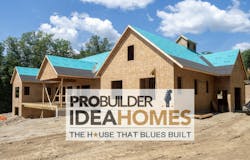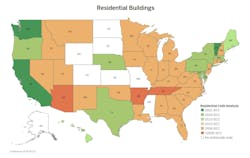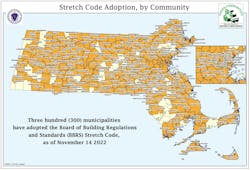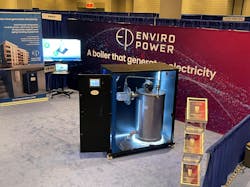Stretching the Budget to Meet the Massachusetts Stretch Code
When Albert and Christina Cummings purchased a prime piece of land in the Berkshire Mountains of Massachusetts back in 2007, they dubbed their future home "The House That Blues Built” in honor of Albert Cummings’ dual career as a custom homebuilder and renowned blues guitarist. The fourth-generation builders and their predecessors have always been committed to sustainability and craftsmanship. Their new home will attain even higher levels of energy efficiency to meet the Massachusetts Stretch Code, which focuses on energy performance and is meant to result in cost-effective construction.
“Everything in the house is impacted by the Stretch Code,” says Albert. “The code affects every decision and every piece of the house from the foundation to the insulation to the choices for every system.”
A New Kind of Energy Code
Massachusetts became the first state to adopt a voluntary Stretch Code in 2009, which is a code with higher energy efficiency standards than the base code. The Massachusetts Board of Building Regulations and Standards (BBRS)) developed the Stretch Code to reduce greenhouse gas emissions in both residential and commercial new construction along with additions and remodels. The state was also among the first to sign the Global Warming Solutions Act of 2008.
The Stretch Code, which is voluntarily adopted by municipalities in the state, does not require specific actions by builders and contractors, but instead focuses on outcomes through HERS (Home Energy Rating System) testing. The goal is to achieve 25% greater energy efficiency than building according to the base code.
Three hundred municipalities in Massachusetts have voted to make the Stretch Code mandatory for new buildings, as Williamstown, where the Cummings’ home is under construction, did in 2011. Under the current Stretch Code, the maximum HERS (Home Energy Rating System) rating for a new residence is 55. The Cummings estimate that their HERS rating will be 45. The lower the rating, the less energy a house uses.
“I think the Stretch Code will eventually become the national code for building, so builders will need to get educated about how to meet these standards,” Albert says. “The HERS analysis is done by trained HERS raters who typically can bring you options and provide input on who has the experience to build this way.”
Under the Stretch Code, builders are expected to design homes for energy efficiency from the start rather than install specific energy efficient systems. For example, building an airtight home with higher levels of insulation, energy efficient windows and a passive solar orientation provide the foundation for a more sustainable home.
As of 2023, updates to Massachusetts codes will require a HERS rating of 52 for the base code for new homes and 42 for the Stretch Code. For a large 4,000-square- foot all-electric single-family home, the Massachusetts Department of Energy Resources estimates construction savings of $3,000 under the Stretch Code along with $17,000 in rebates compared to building to meet the base code. A similarly sized home with gas heat would cost about $10,000 more to build under the Stretch Code, offset by rebates of $7,700.
Stretching the Budget to Meet the Code
Although the Stretch Code is meant to promote cost-effective building practices, the Cummings estimate that meeting the Stretch Code will add $60,000 to $70,000 in expenses to a $1 million house.
“When our town voted in the Stretch Code, supporters said it would add $600 to the cost of a house,” Albert says. “But you have to hire a HERS rater for $2,500 before you can even get an approval to build.” However, he adds that the long-term performance of the house should offset the increased expenses upfront.
“To meet the Stretch Code, you need more insulation and a more efficient heating system,” Albert says. “Although this probably costs 5% to 8% more in the beginning, over the life of the house the higher level of efficiency will repay the costs. Plus, you’re getting a higher quality, more comfortable house.”
Network of Products Needed for High-Performance House
One objective for the House that Blues Built was to work with multiple companies to learn about their products, so even though some of the participants are competitors, the Cummings chose products from each on which they don’t compete.
“They looked at our climate and the position of the house on the site to come up with solutions,” Albert says. “We’ve always come up with new stuff, but we know there’s more than one way to skin a cat. We like to be guinea pigs and work with very smart people who know a lot about building science.”
The Cummings chose a combination of DuPont’s Building Envelope Solutions products for the exterior insulation, including DuPont’s Tyvek HomeWrap, Flashing Tape and FlexWrap. Inside, Owens Corning provided their PINK Next Gen Fiberglas insulation, introduced in 2021, that offers both thermal performance and noise absorption.
“The products work together to create a super airtight system that keeps air and water out of the house,” Albert says.
While designing and building the airtight home, the Cummings and the rest of the team also developed a system to ensure the house is healthy.
“In older homes the air would flow around the windows and doors and people would just put more wood on the fire,” Albert says. “Today, you need to realize that everything in the house is off-gassing, and you need to control the ventilation and humidity. Trane really understands all of these issues and how to address them throughout the house.” Trane’s heat pumps, temperature and humidity sensors, energy recovery ventilator, whole home steam humidifier and whole home air cleaners work together with Broan-Nutone’s fans to provide excellent indoor air quality, Albert says.
The Cummings are excited to be among the first group of builders to install a SmartWatt Boiler from Enviro Power.
“This is brand new technology that is likely to be a leader in the field,” Albert says. “Eventually every company will have to come up with a system like this one. It has an integrated generator that creates energy that goes into the grid while it provides radiant heat to the house and functions as a water heater.”
The SmartWatt Boiler, which is highly efficient, also contributes to the anticipated lower HERS rating for the house.
Although Cummings calls The House That Blues Built “simple,” he’s also proud of the technology and innovation that has gone into creating it.





